Do you know the way to San José?
The last morning in Rodalquilar arrived all to quickly, in our short time here we had fallen in love with this quirky little community of artists and settlers at the heart of the Cabo de Gata. Our fellow group of Inntravellers, always one day behind, waved us off from the sun drenched terrace of El Jardin de los Sueños as we said our farewells, they would meet us again the following day. Eckhard's strange and beautiful garden disappeared into the heat haze of the early morning as we walked up the track and onto the steep incline of the road. This would be the longest route of the trip, approximately 18km with a total ascent of 450m, taking us along the coast through the small fishing village of La Isleta del Moro then up past the twin peaks of El Fraile and on to San José. Feeling like a couple of intrepid explorers striking out before the main group we belted out Dionne Warwick like a couple of kids, until we had to stop to catch our breath from laughing. Would we know the way?
"Do you know the way to San José?
I've been away so long. I may go wrong and lose my way.
Do you know the way to San José?
I'm going back to find some peace of mind in San José"
Burt Bacharach & Hal David
At the peak, we turned and took a last look at Rodalquilar nestled in the centre of its ancient volcano before turning onwards, the road dropping away to reveal a shining vista of ocean and dramatic rocky cliffs. At the end of the road we stopped at the Mirador de la Atamista to soak up this glorious view. The fencing was littered with padlocks signed by lovers and an elderly Spanish couple stood hand in hand before asking shyly if we could take their photo. At the top of the viewing point, a panorama of painted tiles showcased the flora and fauna of the coast.
Turning back to the road, we found a large Montpellier snake, sadly a very recent casualty of the road, possibly whilst we had stood soaking up the view. It was strangely beautiful in death, caught in transit crossing the tarmac. The route notes directed us off the road a few steps later, taking a path downwards into a small valley. Here we followed the blue and white way markers into a rocky gully to a small cove, Cala los Toros, hidden by a narrow path and large palm tree. Cala los Toros was wild and rocky, with large grey pebbles. Facing just the right way to catch a stiff breeze, the sea foamed at our feet as we explored the shoreline. From the cove we retraced our steps back past the other side of the palm and into a small heavily wooded area, enjoying the brief area of cool shade beneath the branches. Once again, the route notes were impressive, providing the necessary detail to skirt a fallen tree obstructing the route.
Back out into the sun the path entered a broad grassy area surrounded by palms and eucalyptus, the twin peaks of El Fraile distinctive in the distance. It felt like North Africa and I would not have been at all surprised to have come across a herd of camels.
The way markers disappeared and the path became a little vague but we found the route, entering a grove of giant whispering eucalyptus and onto another beach, the Playa del Penon Blanco.
A couple of Spanish families were already enjoying the beach as we walked along part of the sandy shore. As the tide was up, we climbed up into the neighbouring car park before heading round to the tiny harbour of La Isleta del Moro. The first restaurant beckoned enticingly, its terrace literally overhanging the beach but we were fairly early so decided to press on. A waiter struggled to lay table linen as the breeze picked up and smiled as we passed. Around the other side of the harbour a bigger bay opened up, a little more sheltered. Boats bobbed on the water and a powerboat full of wetsuit clad divers headed out to explore the depths. The notes recommended the seafront bar La Isleta for a place to stop and it was certainly idyllic. The terrace stretched out to the waters edge, shaded by a rush mat roof, here it felt like a Caribbean island and we pulled up a couple of chairs and watched the divers drop backwards over the edge of their boat. Despite the idyllic environment we couldn't find a single member of staff although it was clearly open, so we set off again with a shrug of the shoulders, we'd enjoyed the view and that was enough.
Back into the sun and up into the central square, La Plaza Virgen del Mar, we spotted a ice cream vendor and ventured over. Sadly they too were unable to refresh this pair of thirsty travellers, as they fought with technical difficulties with a variety of colourful Spanish swearwords. Next door a street food truck specialising in pulpo was just setting up, stirring vast pots of pulpo en arroz, it was hard not to linger until he opened. The light was blinding with the sun bouncing of the brilliantly white tiny church onto the white streets and veering off into a side street into a tiny dark shop we finally found a couple of ice creams, melting almost immediately as we set off back onto the route.
At the end of the village, at another viewpoint with another painted panorama of tiles, we stopped to wipe away traces of ice cream and share a bottle of water and set off again, into an area of low scrubland. Here we found hidden in the grass the circular remains of an ancient threshing floor, the white stones appearing like a pagan symbol from the past. The path dipped down a set of steep steps into a gully, so steep each step involved arms as well as legs to limber down, then up again the other side and into another curving bay, Los Escullos.
On the beach, strange wave like rock formations provided an otherworldly alien atmosphere. These huge white fossilised sand dunes are actually made up from oolitic limestone, individual grains of sand encrusted with calcium carbonate and cemented together millions of years ago. Sculpted by wind and sea erosion into precariously balanced pinnacles along the beach, their forms are reflected in the name of the bay, Los Escullos, from the the Spanish word for reef, escullo.
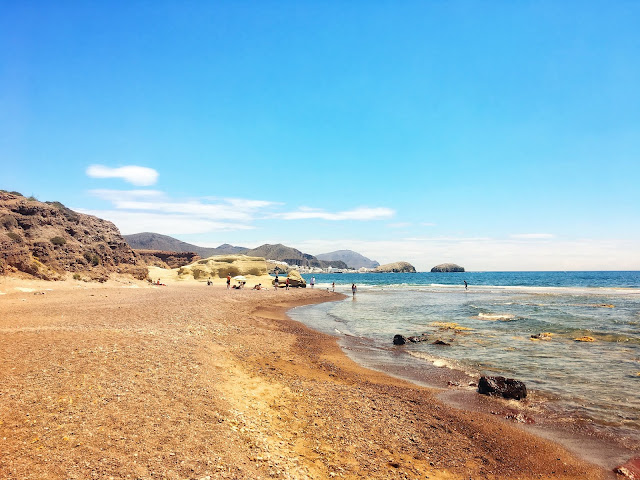 Edging this strange beachscape was a slightly shabby looking bar, restaurant and disco and further along a giant rusting figure of a pirate with an obligatory parrot perched on his shoulder. This odd little community had a real 'buckets and spades' seaside appeal and was pleasingly quiet so early in the season.
Edging this strange beachscape was a slightly shabby looking bar, restaurant and disco and further along a giant rusting figure of a pirate with an obligatory parrot perched on his shoulder. This odd little community had a real 'buckets and spades' seaside appeal and was pleasingly quiet so early in the season.Sitting next to the disco with its colourful entrance poles leading onto the beach was another 18th century fort, the Batería de San Felipe, perched atop a mound of white rock and battered by sea spray. The rusty gates were padlocked but easy to peer through and we walked the perimeter wondering at its history. The fort stood at the bottom of the route leading up to the peaks of El Fraile and it was clear that we would find little shade on the higher ground. The wide thick walls facing away from the sun provided a limited metre of shadow so we sat with our backs against the fortress and unpacked the generous picnic provided by Eckhard. We were surprisingly hungry and devoured the carefully packed boiled eggs, sandwiches, almond cakes and fruit with gusto, watched enviously by a couple of dusty sparrows and sun bathing lizards.
Rested and fed we set off again, passing a strange moonscape of oolitic limestone littered with bright yellow flowers and occasional sea shells, then another windswept beach, Playa Embarcadero. A sign indicated the start of the next stage, the Loma Pelada route which would take us on a wide dusty track up past the peaks of El Fraile, the two dominant points we had seen from a distance since Rodalquilar. The track circled upwards and we were totally alone, just the circling seagulls our company. The wind caught us as we turned each headland providing a refreshing breeze before the next sheltered side were we sweated in the heat and effort of the climb. As we got higher we passed a bentonite clay quarry, a white dusty scar in the scrubby headland. Further along and still climbing upwards, a large ruin stood balanced over the cliffs. The views must have been amazing but this would have been a lonely spot to live and difficult to access too. It was hard to imagine how it had been built, a doorway opened directly onto tumbling rocks below.
Higher and higher we climbed and it was nothing but stunning, the clouds weaving a lace veil of shadow across the peaks. This was the wild Spain we had hoped to see, crashing waves of turquoise blue below and tumbledown rocks covered in a rainbow of wild flowers above, it was breathtaking in every sense. Worries and concerns blew away in the sea breeze and we were reminded what it feels like to be truly alive, this was freedom in its purest form.
Slowly the rough track narrowed into a rocky path, wrapping itself to the cliff face. The route notes had warned of some rock fall along part of this route and sure enough a large overhanging crag had tumbled down almost blocking the narrow path. We scrambled carefully over, not looking downwards, our hearts racing. At the other side, San José and the wide golden curve of Los Genoveses came into view, still just over an hours walk away. We were both sweaty, footsore and desperate for a cold cerveza but the sense of sadness of leaving El Fraile took us by surprise. Somewhere up on this mountain pass, the wild beauty of the Cabo de Gata had caught us in its spell. Reluctantly, we headed down, one section little more than a slip and a slide down some rough scree, I'll admit to using both hands and feet. Dusty, weary and not a little sun kissed we arrived into the town....we did it, we knew the way to San José!
Walkers piled in from the other direction, all walking poles, bandanas and rucksacks of many colours, welcoming us into the camaraderie as fellow hikers with friendly smiles and nods of acknowledgement. Settled on the cushioned benches drinking a well earned beer we retraced our steps from Rodalquilar to San Jose on the map. On foot is definitely the way to see Spain.

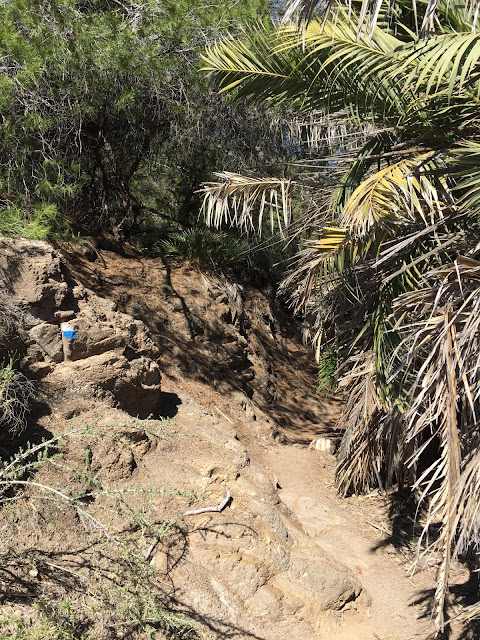
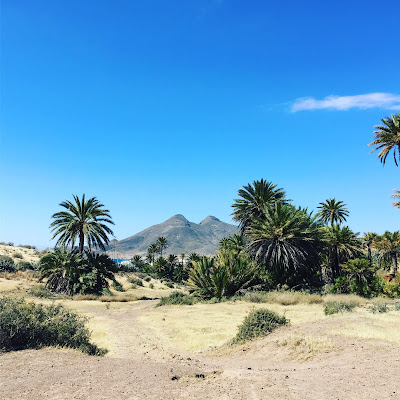
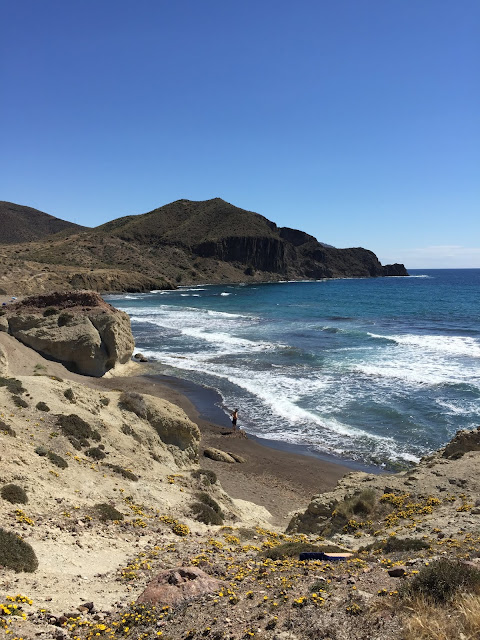

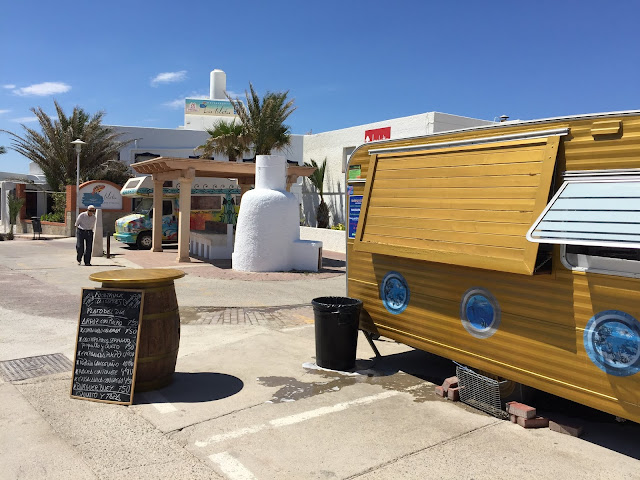
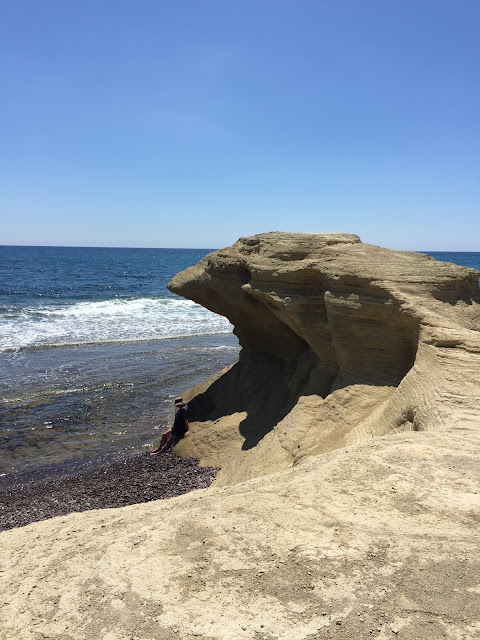


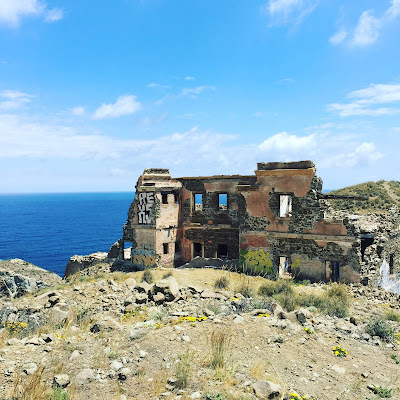
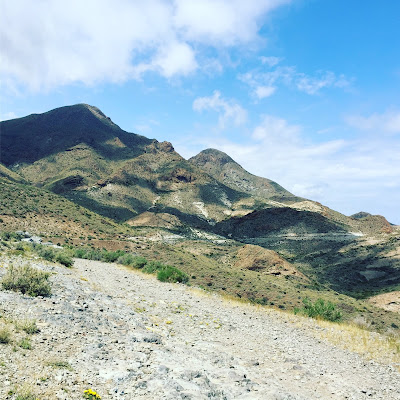

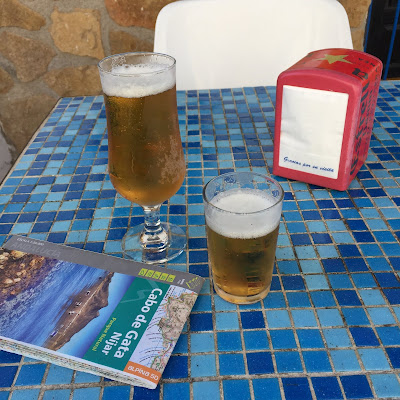




Comments
Post a Comment